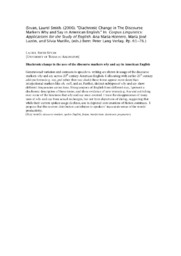
ATTENTION: The works hosted here are being migrated to a new repository that will consolidate resources, improve discoverability, and better show UTA's research impact on the global community. We will update authors as the migration progresses. Please see MavMatrix for more information.
Show simple item record
| dc.contributor.author | Stvan, Laurel Smith | |
| dc.date.accessioned | 2022-07-12T03:13:26Z | |
| dc.date.available | 2022-07-12T03:13:26Z | |
| dc.date.issued | 2006 | |
| dc.identifier.citation | Stvan, Laurel Smith. “Diachronic Change in the Uses of the Discourse Markers Why and Say in American English.” Corpus Linguistics: Applications for the Study of English, edited by Ana María Hornero et al., Peter Lang Verlag, 2006, pp. 61–76. | en_US |
| dc.identifier.isbn | 9783039117260 | |
| dc.identifier.uri | http://hdl.handle.net/10106/30640 | |
| dc.description.abstract | **Please note that the full text is embargoed** ABSTRACT: Generational variation and contrasts in speech vs. writing are shown in usage of the discourse markers why and say across 20th century American English. Collocating with earlier 20th century address forms (e.g. say, pal rather then say, dude) these forms appear more dated than interjectional markers like oh, well, and so, Further, distinct subtypes of why and say show different frequencies across time. Using corpora of English from different eras, I present a diachronic description of these terms, and show evidence of new terms (e.g. hey and yo) taking over some of the functions that why and say once covered. I trace the disappearance of many uses of why and say from actual exchanges, but not from depictions of dialog, suggesting that while their current spoken usage declines, use in depicted conversations of fiction continues. I propose that this uneven distribution contributes to speakers’ inaccurate sense of the words’
productivity. | en_US |
| dc.language.iso | en_US | en_US |
| dc.publisher | Peter Lang Verlag | en_US |
| dc.relation.ispartofseries | Linguistic Insights; | |
| dc.subject | discourse markers, corpus linguistics, diachronic English, interjections, pragmatics, fiction | en_US |
| dc.title | Diachronic Change in The Discourse Markers "Why" and "Say" in American English | en_US |
| dc.type | Book chapter | en_US |
Files in this item
- Name:
- stvan (2006) why and say.pdf
- Size:
- 182.9Kb
- Format:
- PDF
This item appears in the following Collection(s)
Show simple item record


